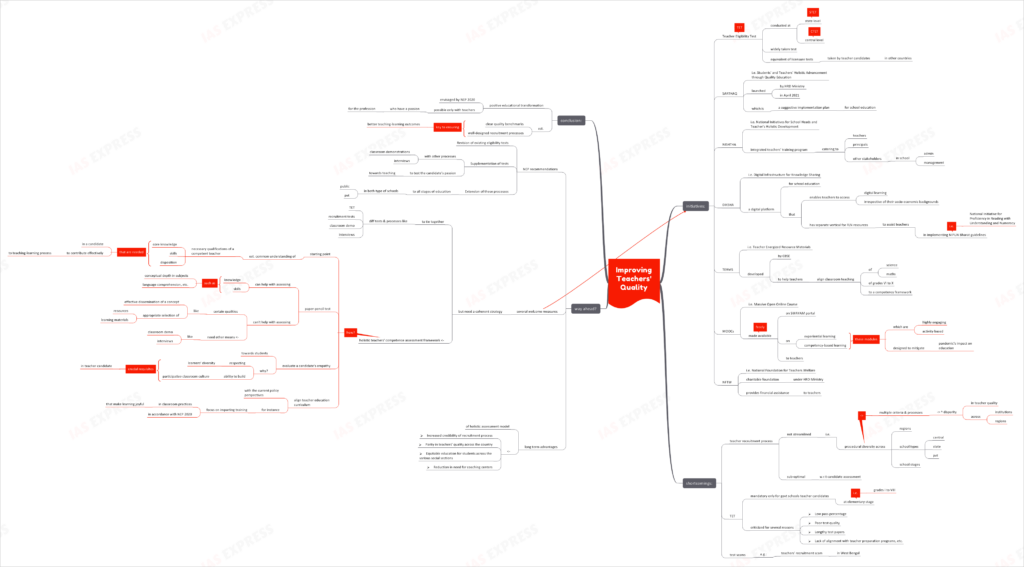Improving Teachers’ Quality

From Current Affairs Notes for UPSC » Editorials & In-depths » This topic
IAS EXPRESS Vs UPSC Prelims 2024: 80+ questions reflected
What are some initiatives taken to improve teaching quality?
- TET or Teacher Eligibility Test is conducted at state level (as STET) and at the central level (CTET). This widely taken test is the equivalent of licensure tests taken by teacher candidates in other countries.
- In April 2021, the HRD Ministry launched SARTHAQ or ‘Students’ and Teachers’ Holistic Advancement through Quality Education’. It is a suggestive implementation plan for school education.
- NISHTHA or National Initiatives for School Heads and Teacher’s Holistic Development is an integrated teachers’ training program that caters to teachers, principals and other stakeholders in school administration and management.
- DIKSHA or Digital Infrastructure for Knowledge Sharing is a digital platform for school education. It enables teachers to access digital learning, irrespective of their socio-economic backgrounds. In this platform, a separate vertical for FLN (foundational numeracy and literacy) resources assists teachers in implementing NIPUN (National Initiative for Proficiency in Reading with Understanding and Numeracy) Bharat guidelines
- TERMs or Teacher Energized Resource Materials was developed by CBSE to help teachers align classroom teaching of science and mathematics (of grades VI to X) to a competency framework.
- MOOCs (Massive Open Online Course) on experiential learning and competency-based learning have been made freely available to teachers via SWAYAM portal. These modules are activity-based and highly engaging and are designed to mitigate the pandemic’s impact on education.
- The NFTW (National Foundation for Teachers Welfare) is a charitable foundation, under the HRD Ministry, that provides financial assistance to teachers.

What are the shortcomings?
- The teacher recruitment process is not streamlined due to the procedural diversity across regions, school types (central/ state/ private) and stages. This has created multiple criteria and processes, leading to huge disparity in teacher quality across institutions and regions.
- Many recruitment processes are sub-optimal when it comes to assessment of a candidate’s competency.
- The TET is mandatory only for government school teacher candidates, that too at the elementary stage (grades I to VIII).
- The TET is also criticized for other reasons:
- Low pass percentage
- Poor test quality
- Lengthy test papers
- Lack of alignment with teacher preparation programs, etc.
- In addition to this, these tests have been in news over scams. For instance, a teachers’ recruitment scam in West Bengal has been in news recently.
What needs to be done?
- The NEP 2020 has recommended:
- Revision of existing eligibility tests
- Supplementation of tests with other processes like classroom demonstrations and interviews to test the candidate’s passion towards teaching.
- Extension of these processes to all stages of education in both public and private schools.
- While there have been several welcome measures, a coherent strategy is needed to tie the different tests and processes, like the TET, recruitment tests, classroom demo and interviews, together. There is a need for a holistic teachers’ competence assessment framework.
- A starting point could be establishing a common understanding of the necessary qualifications of a competent teacher i.e. the core knowledge, skills and disposition that are needed in a candidate to contribute to the teaching-learning process effectively.
- While a paper-pencil test can help assess a teacher candidate’s knowledge and skills like conceptual depth in subjects, language comprehension, etc., other qualities (like effective dissemination of a concept, appropriate selection of resources and learning materials, etc.) require the use of classroom demo and interviews.
- The assessment process must also evaluate a candidate’s empathy towards students. Respecting the learners’ diversity and the ability to build a participative classroom culture are vital requisites of a teacher.
- The teacher education curriculum needs to align with the current policy perspectives. For instance, in accordance with the NEP 2020, teacher education curriculum could focus on imparting training in classroom practices that make the learning practice joyful.
- Such a holistic assessment model has multiple long term advantages:
- Increased credibility of recruitment process
- Parity in teachers’ quality across the country
- Equitable education for students across the various social sections
- Reduction in need for coaching centers
Conclusion:
The positive educational transformation, as envisaged by the NEP 2020, is possible only with teachers who have a passion for the profession. Establishing clear quality benchmarks and using well-designed recruitment processes are key to ensuring better teaching-learning outcomes.
Practice Question for Mains:
What are the shortcomings of teachers’ recruitment process in India? How can the situation be addressed in pursuit of NEP 2020 objectives? (250 words)
If you like this post, please share your feedback in the comments section below so that we will upload more posts like this.

